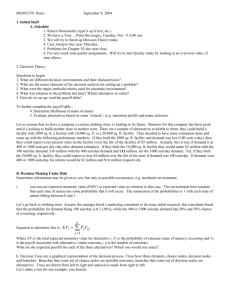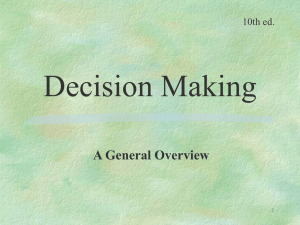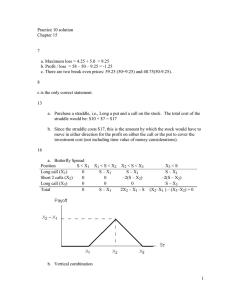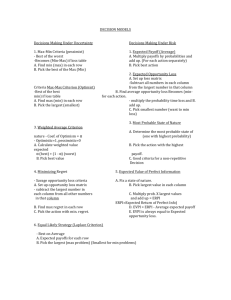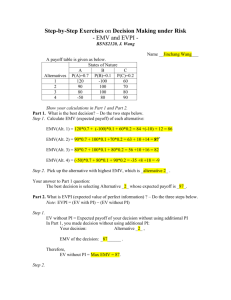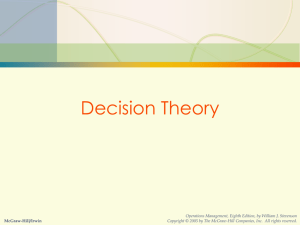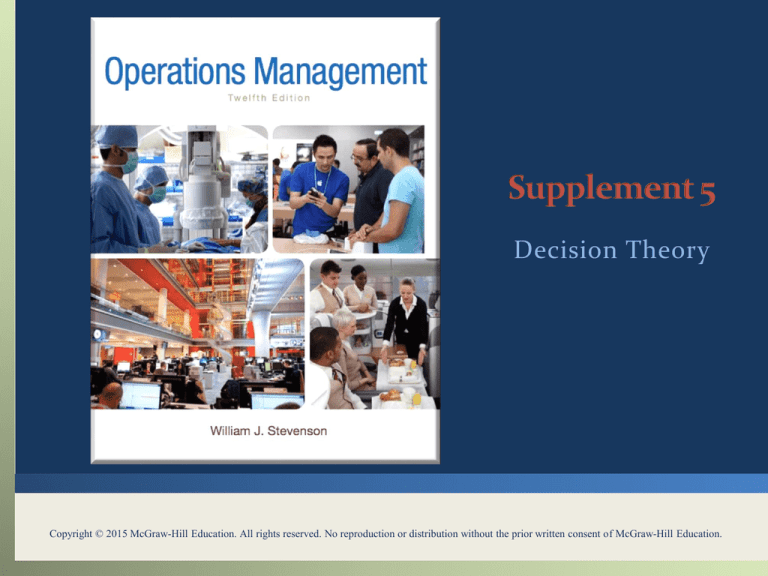
Decision Theory
Copyright © 2015 McGraw-Hill Education. All rights reserved. No reproduction or distribution without the prior written consent of McGraw-Hill Education.
You should be able to:
LO 5s.1
LO 5s.2
LO 5s.3
LO 5s.4
LO 5s.5
LO 5s.6
LO 5s.7
Outline the steps in the decision process
Name some causes of poor decisions
Describe and use techniques that apply to decision making
under uncertainty
Describe and use the expected-value approach
Construct a decision tree and use it to analyze a problem
Compute the expected value of perfect information
Conduct sensitivity analysis on a simple decision problem
5s-2
A general approach to decision making that is suitable
to a wide range of operations management decisions
Capacity planning
Product and service design
Equipment selection
Location planning
5s-3
Characteristics of decisions that are suitable for using
decision theory
A set of possible future conditions that will have a
bearing on the results of the decision
A list of alternatives from which to choose
A known payoff for each alternative under each possible
future condition
5s-4
1.
2.
3.
4.
5.
Identify the possible future states of nature
Develop a list of possible alternatives
Estimate the payoff for each alternative for each possible
future state of nature
If possible, estimate the likelihood of each possible future
state of nature
Evaluate alternatives according to some decision criterion
and select the best alternative
LO 5s.1
5s-5
A table showing the expected payoffs for each
alternative in every possible state of nature
Possible Future Demand
Alternatives
Low
Moderate
High
Small facility
$10
$10
$10
7
12
12
(4)
2
16
Medium facility
Large Facility
• A decision is being made concerning which size facility
should be constructed
• The present value (in millions) for each alternative under
each state of nature is expressed in the body of the above
payoff table
LO 5s.1
5s-6
Steps:
1.
Identify the problem
2. Specify objectives and criteria for a solution
3. Develop suitable alternatives
4. Analyze and compare alternatives
5. Select the best alternative
6. Implement the solution
7. Monitor to see that the desired result is achieved
LO 5s.1
5s-7
Decisions occasionally turn out poorly due to
unforeseeable circumstances; however, this is not the
norm.
More frequently poor decisions are the result of a
combination of
Mistakes in the decision process
Bounded rationality
Suboptimization
LO 5s.2
5s-8
Errors in the Decision Process
Failure to recognize the importance of each step
Skipping a step
Failure to complete a step before jumping to the next step
Failure to admit mistakes
Inability to make a decision
LO 5s.2
5s-9
Bounded rationality
The limitations on decision making caused by costs,
human abilities, time, technology, and availability of
information
Suboptimization
The results of different departments each attempting to
reach a solution that is optimum for that department
LO 5s.2
5s-10
There are three general environment categories:
Certainty
Environment in which relevant parameters have known
values
Risk
Environment in which certain future events have
probabilistic outcomes
Uncertainty
Environment in which it is impossible to assess the likelihood
of various possible future events
LO 5s.3
5s-11
Decisions are sometimes made under complete
uncertainty: No information is available on how likely
the various states of nature are.
Decision Criteria:
Maximin
Choose the alternative with the best of the worst possible payoffs
Maximax
Choose the alternative with the best possible payoff
Laplace
Choose the alternative with the best average payoff
Minimax regret
Choose the alternative that has the least of the worst regrets
LO 5s.3
5s-12
Possible Future Demand
Alternatives
Low
Moderate
High
Small Facility
$10
$10
$10
7
12
12
(4)
2
16
Medium Facility
Large Facility
•The worst payoff for each alternative is
Small facility:
$10 million
Medium facility
$7 million
Large facility
-$4 million
•Choose to construct a small facility
LO 5s.3
5s-13
Possible Future Demand
Alternatives
Low
Moderate
High
Small Facility
$10
$10
$10
7
12
12
(4)
2
16
Medium Facility
Large Facility
•The best payoff for each alternative is
Small facility:
$10 million
Medium facility
$12 million
Large facility
$16 million
•Choose to construct a large facility
LO 5s.3
5s-14
Possible Future Demand
Alternatives
Low
Moderate
High
Small Facility
$10
$10
$10
7
12
12
(4)
2
16
Medium Facility
Large Facility
•The average payoff for each alternative is
Small facility:
(10+10+10)/3 = $10 million
Medium facility
(7+12+12)/3 = $10.33 million
Large facility
(-4+2+16)/3 = $4.67 million
•Choose to construct a medium facility
LO 5s.3
5s-15
Possible Future Demand
Alternatives
Low
Moderate
High
Small Facility
$10
$10
$10
7
12
12
(4)
2
16
Medium Facility
Large Facility
•Construct a regret (or opportunity loss) table
•The difference between a given payoff and the best
payoff for a state of nature
Regrets
LO 5s.3
Alternatives
Low
Moderate
High
Small Facility
$0
$2
$6
Medium Facility
3
0
4
Large Facility
14
10
0
5s-16
Regrets
Alternatives
Low
Moderate
High
Small Facility
$0
$2
$6
Medium Facility
3
0
4
Large Facility
14
10
0
•Identify the worst regret for each alternative
•Small facility
$6 million
•Medium facility
$4 million
•Large facility
$14 million
•Select the alternative with the minimum of the maximum
regrets
•Build a medium facility
LO 5s.3
5s-17
Decisions made under the condition that the
probability of occurrence for each state of nature can
be estimated
A widely applied criterion is expected monetary value
(EMV)
EMV
Determine the expected payoff of each alternative, and choose
the alternative that has the best expected payoff
This approach is most appropriate when the decision maker is
neither risk averse nor risk seeking
LO 5s.4
5s-18
Possible Future Demand
Alternatives
Low (.30)
Moderate (.50)
High (.20)
Small Facility
$10
$10
$10
7
12
12
(4)
2
16
Medium Facility
Large Facility
EMVsmall = .30(10) +.50(10) +.20(10) = 10
EMVmedium = .30(7) + .50(12) + .20(12) = 10.5
EMVlarge = .30(-4) + .50(2) + .20(16) = $3
Build a medium facility
LO 5s.4
5s-19
Decision tree
A schematic representation of the available alternatives and their
possible consequences
Useful for analyzing sequential decisions
LO 5s.5
5s-20
Composed of
Nodes
Decisions – represented by square nodes
Chance events – represented by circular nodes
Branches
Alternatives– branches leaving a square node
Chance events– branches leaving a circular node
Analyze from right to left
For each decision, choose the alternative that will yield
the greatest return
If chance events follow a decision, choose the alternative
that has the highest expected monetary value (or lowest
expected cost)
LO 5s.5
5s-21
A manager must decide on the size of a video arcade to construct. The
manager has narrowed the choices to two: large or small. Information has been
collected on payoffs, and a decision tree has been constructed. Analyze the
decision tree and determine which initial alternative (build small or build
large) should be chosen in order to maximize expected monetary value.
$40
$40
2
Overtime
$50
$55
1
($10)
2
$50
LO 5s.5
$70
5s-22
$40
$40
2
Overtime
$50
$55
1
($10)
2
$50
$70
EVSmall = .40(40) + .60(55) = $49
EVLarge = .40(50) + .60(70) = $62
LO 5s.5
Build the large facility
5s-23
Expected value of perfect information (EVPI)
The difference between the expected payoff with perfect
information and the expected payoff under risk
Two methods for calculating EVPI
EVPI = expected payoff under certainty – expected payoff under risk
EVPI = minimum expected regret
LO 5s.6
5s-24
Possible Future Demand
Alternatives
Low (.30)
Moderate (.50)
High (.20)
Small Facility
$10
$10
$10
7
12
12
(4)
2
16
Medium Facility
Large Facility
EVwith perfect information = .30(10) + .50(12) + .20(16) = $12.2
EMV = $10.5
EVPI = EVwith perfect information – EMV
= $12.2 – 10.5
= $1.7
You would be willing to spend up to $1.7 million to obtain
perfect information
LO 5s.6
5s-25
Regrets
Alternatives
Low (.30)
Moderate (.50)
High (.20)
Small Facility
$0
$2
$6
Medium Facility
3
0
4
Large Facility
14
10
0
• Expected Opportunity Loss
• EOLSmall = .30(0) + .50(2) + .20(6) = $2.2
• EOLMedium = .30(3) + .50(0) + .20(4) = $1.7
• EOLLarge = .30(14) + .50(10) + .20(0) = $9.2
• The minimum EOL is associated with the building the
medium size facility. This is equal to the EVPI, $1.7
million
LO 5s.6
5s-26
Sensitivity analysis
Determining the range of probability for which an
alternative has the best expected payoff
The approach illustrated is useful when there are two
states of nature
It involves constructing a graph and then using algebra to
determine a range of probabilities over which a given solution
is best.
LO 5s.7
5s-27
State of
Nature
Alternative
#1
#2
Slope
Equation
A
4
12
12 – 4 = +8
4 + 8P(2)
B
16
2
2 – 16 = -14
16 – 14P(2)
C
12
8
8 - 12 = -4
12 – 4P(2)
LO 5s.7
5s-28

